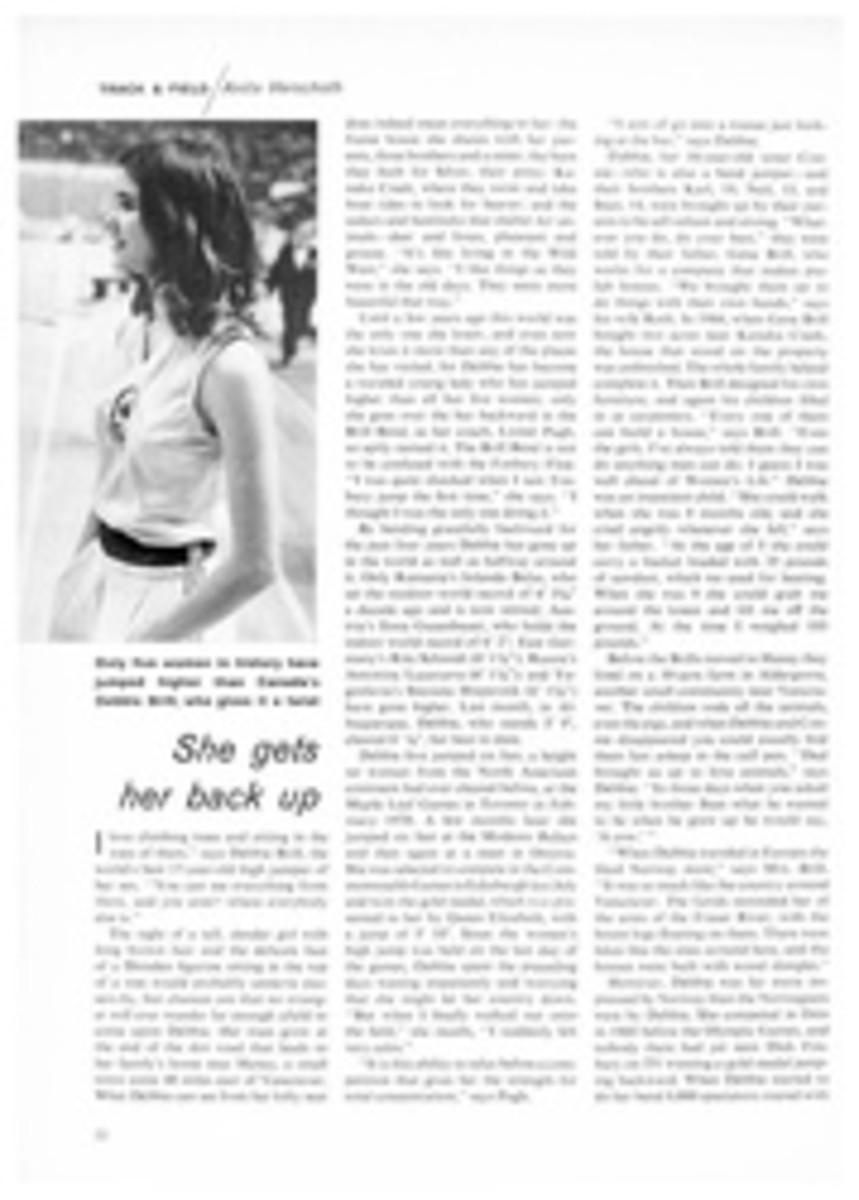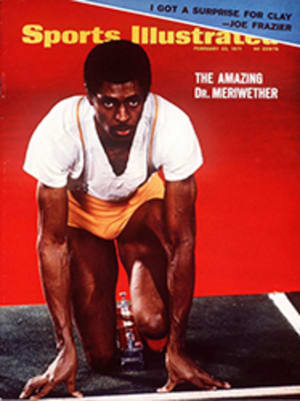
She gets her back up
I love climbing trees and sitting in the tops of them," says Debbie Brill, the world's best 17-year-old high jumper of her sex. "You can see everything from there, and you aren't where everybody else is."
The sight of a tall, slender girl with long brown hair and the delicate face of a Dresden figurine sitting in the top of a tree would probably unnerve passers-by, but chances are that no stranger will ever wander far enough afield to come upon Debbie. Her trees grow at the end of the dirt road that leads to her family's home near Haney, a small town some 40 miles east of Vancouver. What Debbie can see from her lofty seat does indeed mean everything to her: the frame house she shares with her parents, three brothers and a sister; the barn they built for Silver, their pony; Kanaka Creek, where they swim and take boat rides to look for beaver; and the cedars and hemlocks that shelter her animals—deer and foxes, pheasant and grouse. "It's like living in the Wild West," she says. "I like things as they were in the old days. They seem more beautiful that way."
Until a few years ago this world was the only one she knew, and even now she loves it more than any of the places she has visited, for Debbie has become a traveled young lady who has jumped higher than all but five women; only she goes over the bar backward in the Brill Bend, as her coach, Lionel Pugh, so aptly named it. The Brill Bend is not to be confused with the Fosbury Flop. "I was quite shocked when I saw Fosbury jump the first time," she says. "I thought I was the only one doing it."
By bending gracefully backward for the past four years Debbie has gone up in the world as well as halfway around it. Only Rumania's Iolanda Balas, who set the outdoor world record of 6'3¼" a decade ago and is now retired; Austria's Ilona Gusenbauer, who holds the indoor world record of 6'2"; East Germany's Rita Schmidt (6'1¾"); Russia's Antonina Lazaryeva (6'1¾"); and Yugoslavia's Snezana Hrepevnik (6'1¼") have gone higher. Last month, in Albuquerque, Debbie, who stands 5'9", cleared 6'¾", her best to date.
Debbie first jumped six feet, a height no woman from the North American continent had ever cleared before, at the Maple Leaf Games in Toronto in February 1970. A few months later she jumped six feet at the Modesto Relays and then again at a meet in Ottawa. She was selected to compete in the Commonwealth Games in Edinburgh last July and won the gold medal, which was presented to her by Queen Elizabeth, with a jump of 5'10". Since the women's high jump was held on the last day of the games, Debbie spent the preceding days waiting impatiently and worrying that she might let her country down. "But when I finally walked out onto the field," she recalls, "I suddenly felt very calm."
"It is this ability to relax before a competition that gives her the strength for total concentration," says Pugh.
"I sort of go into a trance just looking at the bar," says Debbie.
Debbie, her 16-year-old sister Connie—who is also a bend jumper—and their brothers Karl, 19, Neil, 15, and Stan, 14, were brought up by their parents to be self-reliant and strong. "Whatever you do, do your best," they were told by their father, Gene Brill, who works for a company that makes prefab houses. "We brought them up to do things with their own hands," says his wife Ruth. In 1966, when Gene Brill bought two acres near Kanaka Creek, the house that stood on the property was unfinished. The whole family helped complete it. Then Brill designed his own furniture, and again his children filled in as carpenters. "Every one of them can build a house," says Brill. "Even the girls. I've always told them they can do anything men can do. I guess I was well ahead of Women's Lib." Debbie was an impatient child. "She could walk when she was 8 months old, and she cried angrily whenever she fell," says her father. "At the age of 5 she could carry a bucket loaded with 35 pounds of sawdust, which we used for heating. When she was 9 she could grab me around the knees and lift me off the ground. At the time I weighed 185 pounds."
Before the Brills moved to Haney they lived on a 10-acre farm in Aldergrove, another small community near Vancouver. The children rode all the animals, even the pigs, and when Debbie and Connie disappeared you could usually find them fast asleep in the calf pen. "Dad brought us up to love animals," says Debbie. "In those days when you asked my little brother Stan what he wanted to be when he grew up he would say, 'A cow.' "
"When Debbie traveled in Europe she liked Norway most," says Mrs. Brill. "It was so much like the country around Vancouver. The fjords reminded her of the arms of the Fraser River, with the boom logs floating on them. There were lakes like the ones around here, and the houses were built with wood shingles."
However, Debbie was far more impressed by Norway than the Norwegians were by Debbie. She competed in Oslo in 1968 before the Olympic Games, and nobody there had yet seen Dick Fosbury on TV winning a gold medal jumping backward. When Debbie started to do her bend 8,000 spectators roared with laughter. Debbie was so shaken she only cleared 4'11", five inches under her personal best at the time. "That proved to the Norwegians that the backward jump didn't work," says Pugh.
Debbie and Connie started jumping in the first grade. They were scissors jumpers and just couldn't learn the more efficient straddle. In fact their coach in those days, Pete Swensson, used to tell them that they would never become any good. Connie could probably be as good a jumper as Debbie—she adopted the bend and she is also coached by Pugh—but she lacks Debbie's aggressiveness.
"We were very different when we were young," says Debbie. "Connie liked dolls and I liked trucks. I liked to climb trees and to beat up boys." Now that Debbie is a celebrity, Connie has contentedly taken second place, so much so that she doesn't want to defeat her sister. Last year at a high school meet Debbie took the opening height of 5'2½" too lightly and failed three times. Connie went on to win. Both sisters cried—Debbie because she was angry at herself, Connie because she wanted Debbie to win. "I can't see how I could ever be jealous of Debbie's success," says Connie.
Debbie's success started one day in 1967 when she was invited to compete in Kelowna, B.C., where she had her first opportunity to jump into a foam-rubber pit, a necessity for backward landing. "That day I improved from 4'8" to 4'11"," she recalls. "I thought I was doing the scissors, but in fact I was kind of going sideways, laying out over the bar. Everybody said, 'Do you know you are going over backwards?' At first I didn't like to be different, but then it became kind of fun."
Later that year Pugh, who also coaches the Canadian national team, saw her jump for the first time. "I was fascinated," he recalls, "but I kept thinking: Why doesn't she run up to the bar in an arc as Fosbury does? She had an almost straight approach. I thought about it for four nights. Then it became clear to me: she was right and I was wrong. Her approach was far more efficient than Fosbury's."
Fortunately, Debbie's father and Pugh have the same philosophy. "I believe a coach's role, like a parent's, should be to kick the fledgling out of the nest as soon as possible," Pugh says. "A coach should never be a crutch. I don't believe in Svengali coaches. Debbie comes to Vancouver once a week and I coach her for 2½ hours. Then I give her a program for the rest of the week. She has to be able to stand on her own two feet. Her jump was already perfect when she came to me. All I could do was give her a more stable approach and give her a taste of what hard work is really like. I am an egotist, and I would like to feel that I have produced her, but that is not so. An experienced athlete contributes as much as the coach does, and Debbie has already contributed more than I."
Pugh has converted other hapless jumpers to the bend. Debbie's teammate Brenda Steffanson improved from 5'4" to 5'8" after she abandoned the straddle, and John Hawkins won a silver medal at last year's Commonwealth Games with a bend jump of 6'11½", a Canadian record and nine inches over his best straddle jump.
As for Debbie, her goals are as high as the cedars in Haney. "I think I can do 6'6" one day," she says. "If a man can jump way over his own height, so should a woman. I don't think I can do it right now, because I don't have the strength; I mean, the kind of strength you get when you get older. I even think about seven feet, but it's kind of a dream."
Two weeks ago Debbie was again in Toronto for the Maple Leaf Games. She had a late lunch with John Dobroth, a straddle jumper from Los Angeles. Debbie ordered a huge bowl of sliced bananas with cream. Dobroth winced. "Those bananas will make your stomach feel nice and heavy," he said. "I would just faint without them," said Debbie. "I'd be standing there, ready to jump, thinking, 'Oh, I'm so hungry.' "
Debbie was the only girl to clear 5'10" that night. It looked easy: nine light-footed steps toward the bar; a twist; the bend with her hips over the bar, her head and legs low on either side of it; then a jackknife, bringing her head up, her back down and her legs over.
"If she bends, so shall she unbend," said Pugh. "It's the Newton doctrine, a very efficient jump."
Debbie had the bar raised to 6'1", which would have meant a new personal best and a new Canadian record, but she brushed it off three times. "It would have been no good going to only six feet," she said, visibly annoyed. "I have made that often enough."
PHOTO

